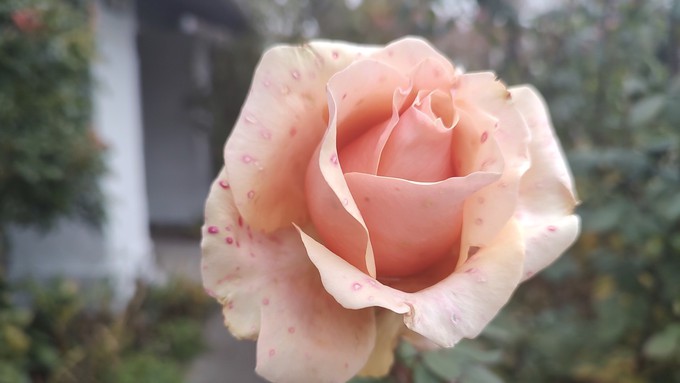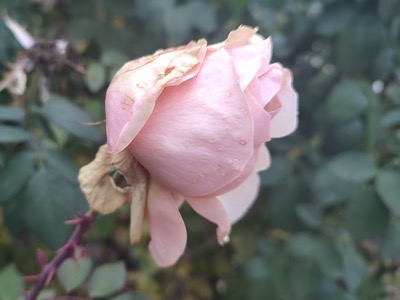
Botrytis outbreak on roses, poinsettias follows chilly, damp weather

This Marilyn Monroe rose is showing early signs of botrytis: The red spots are the symptoms. Debbie Arrington
Sacramento experienced record cold weather this past weekend and thick damp fog that seemed to just hang around.
How will this combination of cold and damp affect our gardens? A rapid shutdown to dormancy. Any fall foliage clinging to branches is dropping now.

This weather also kicks some fungal diseases into high gear. My roses saw a massive attack of botrytis – gray mold – and it’s not pretty.
According to the National Weather Service, downtown Sacramento recorded lows of 32 degrees on Dec. 17 and 18 – records for both dates. With relentless fog, Sunday (Dec. 18) was the coldest day in downtown Sacramento since January 2001; the high topped out at 42.
The fog is linked to all our ground moisture, thanks to recent rains. Lack of wind and sun keeps the fog trapped close to the ground. And that fog creates ideal conditions for gray mold.
Gray mold – which actually looks more tan or brown on the rosebud – needs moisture for growth in plant tissues, particularly tender flower petals. To prevent outbreaks, keep flower buds dry. That’s all but impossible on damp, foggy days.
Thanks to dry and warm fall weather, I had dozens of rose buds in my garden and was hoping to make some Christmas bouquets. But after so much fog and frosty nights, I’ll have few if any roses for my holiday table.
Gray mold starts out looking like pink measles or brownish water spots on light-colored flowers. Those brown spots rapidly grow until the fungus consumes the whole petal. The flower never fully opens.
Another victim to gray mold this season: Poinsettias. If left outside, they turn to mush.
Gray mold also attacks African violet, asters, begonia, carnation, chrysanthemum, cyclamen, cymbidium, gerbera, geranium, gladiolus, hydrangea, marigolds, orchids, petunia, primrose, ranunculus, snapdragon, zinnias and many other garden favorites.
According to UC Integrated Pest Management program, the best control of gray mold is “good sanitation.” Clip off infected blooms, put them in a plastic bag and dispose of them in the trash. Do not compost them; that just recycles the spores back into the garden. Pick up fallen blooms and petals around the bush and dispose of them, too.
(Since this is already pruning time, I’ll remove those infected blooms in a pass through my garden before I tackle pruning the canes.)
After pruning, rake out old mulch and fallen foliage. (This contains other fungal spores, too, for powdery mildew, rust, black spot and other rose diseases.) Then, dispose of that old mulch and replace it with fresh mulch.
For more information on gray mold, check out these pest notes from UC IPM: http://ipm.ucanr.edu/PMG/r280100511.html
Comments
0 comments have been posted.Sacramento Digs Gardening to your inbox.
Sites We Like
Garden Checklist for week of May 5
Survey your garden after the May 4 rainstorm. Heavy rain and gusty winds can break the neck of large flowers such as roses. Also:
* Keep an eye on new transplants or seedlings; they could take a pounding from the rain.
* Watch out for powdery mildew. Warmth following moist conditions can cause this fungal disease to “bloom,” too. If you see a leaf that looks like it’s dusted with powdered sugar, snip it off.
* After the storm, start setting out tomato transplants, but wait on the peppers and eggplants (they want warmer nights). Pinch off any flowers on new transplants to make them concentrate on establishing roots instead of setting premature fruit.
* Trim dead flowers but not leaves from spring-flowering bulbs such as daffodils and tulips. Those leaves gather energy to create next year's flowers. Also, give the bulbs a fertilizer boost after bloom.
* Pinch chrysanthemums back to 12 inches for fall flowers. Cut old stems to the ground.
* Mulch around plants to conserve moisture and control weeds.
* From seed, plant beans, beets, cantaloupes, carrots, corn, cucumbers, melons, pumpkins, radishes and squash.
* Plant onion sets.
* In the flower garden, plant seeds for asters, cosmos, celosia, marigolds, salvia, sunflowers and zinnias. Transplant petunias, zinnias, geraniums and other summer bloomers.
* Plant perennials and dahlia tubers for summer bloom.
* Don’t wait; plant summer bulbs, such as gladiolus and tuberous begonias.
* Harvest cabbage, lettuce, peas and green onions.